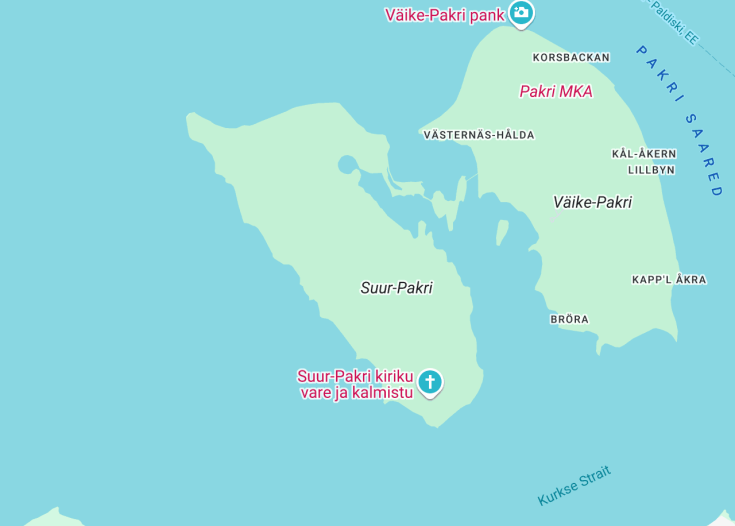Located off the northern coast of Estonia, Suur-Pakri Island is a hidden gem known for its breathtaking natural beauty and rich historical significance. The island offers visitors a chance to explore serene landscapes, diverse wildlife, and remnants of its maritime past. With limited human intervention, Suur-Pakri is a paradise for nature enthusiasts and a perfect destination for those seeking tranquility away from crowded tourist spots. Historically significant, the island features architectural monuments that reflect its storied past, inviting travelers to delve into its unique cultural heritage.
For an enriching experience, consider visiting Suur-Pakri during the warmer months when the wildlife is most active and the weather is conducive for outdoor activities like hiking and birdwatching.
Plan your visit to include a guided tour to fully appreciate the island’s historical sites and natural wonders. Early mornings offer stunning views and increased opportunities for wildlife sightings, making it an ideal time for photography enthusiasts.
Top things to do & see in Suur-Pakri
Select the following sights and activities to discover best tickets and tours available in Suur-Pakri.
Suur-Pakri: A Hidden Gem in the Baltic Sea
| Country | Estonia |
| Time in Suur-Pakri | GMT+2 |
| Language spoken | Estonian |
| Population | Approximately 141 (source: Estonian Statistical Office) |
| Currency | Euro (EUR, €) |
| Airports |
|
Suur-Pakri is a fascinating island located in Estonia’s picturesque Baltic Sea, known for its stunning natural landscapes and unique cultural heritage. The island is part of a small archipelago situated near the west coast of Estonia and is characterized by its rich history and biodiversity. Historically, Suur-Pakri has been a site of arable farming and fishing, but it has recently become popular for nature tourism, drawing in visitors who seek adventure and tranquility in a captivating environment. The area boasts various hiking trails, some of which lead to scenic viewpoints overlooking the sea, making it a hotspot for outdoor enthusiasts. The local community is small but vibrant, and the island’s charm is amplified by its welcoming atmosphere. Visitors can also learn about the traditional lifestyle of the islanders and explore the remnants of old farms and other structures that date back centuries, making Suur-Pakri a beautiful blend of history and nature.
Where is Suur-Pakri?
Suur-Pakri is located in the Baltic Sea, about 31 miles (50 km) from the Estonian capital, Tallinn, and forms part of a small archipelago.
Distances:
| Route | Distance by car | Time by car |
|---|---|---|
| Tallinn to Suur-Pakri | 31 mi | 1 hr 30 min |
| Kuressaare to Suur-Pakri | 61 mi | 1 hr 45 min |
| Riga (Latvia) to Suur-Pakri | 125 mi | 2 hr 30 min |
What is Suur-Pakri famous for?
Suur-Pakri is famous for its stunning natural scenery, diverse wildlife, and rich history, including remnants of old settlements and traditional Estonian architecture.
History
Prehistoric Era (Before 1300 AD)
Prior to the emergence of documented history, Suur-Pakri, along with its smaller sister islands, was primarily inhabited by ancient hunter-gatherer communities. Archaeological evidence suggests that these early inhabitants relied on the abundant marine and terrestrial resources provided by the rich ecosystems surrounding the islands. The strategic location of Suur-Pakri likely made it an ideal site for fishing and seasonal hunting.
Medieval Period (1300 AD – 1500 AD)
The first significant written records regarding Suur-Pakri appear during the 13th and 14th centuries as the island came under the influence of the Hanseatic League. Its strategic position in the Baltic Sea caught the attention of various regional powers. The establishment of trade routes contributed to the island’s prominence, albeit briefly, before its abandonment due to changing political circumstances and conflicts typical of the period.
Early Modern Period (1500 AD – 1700 AD)
In the 16th and 17th centuries, Suur-Pakri transformed as the demands of the burgeoning maritime trade resumed. The island became associated with agriculture, and the settling of Dutch fishermen marked an important demographic shift. Moreover, during this era, Swedish and Russian influences began to permeate the region, significantly affecting local governance and societal structures.
Modern Era (1700 AD – 1900 AD)
The 18th and 19th centuries ushered in an age of economic prosperity for Suur-Pakri. The establishment of fish processing industries and the growth of agricultural practices became central to the island’s economy. The population stabilised and increased, further enhancing the community’s cultural development. Local government systems started to evolve, paving the way for a more structured societal framework.
20th Century to Present (1900 AD – Today)
The 20th century was a turbulent time for Suur-Pakri, particularly during the two World Wars and the Soviet occupation of Estonia. The island witnessed population declines and infrastructure deterioration. However, since Estonia regained independence in 1991, Suur-Pakri has gradually been revitalised. Today, it is celebrated for its untouched landscapes and serves as a focal point for eco-tourism and educational endeavours regarding maritime history and conservation. Visitors are now drawn to its serene environment and rich heritage, with ongoing efforts to preserve and celebrate its unique cultural legacy.
Visit Suur-Pakri
What to see and do in Suur-Pakri, Estonia.
Suur-Pakri offers a variety of attractions and activities for visitors looking to explore its natural beauty and historic significance. Among the key points of interest are:
- Prison Island: An impressive historical site that once served as a confinement location.
- Suur-Pakri Lighthouse: A prominent landmark that provides stunning views of the surrounding sea.
- Hiking Trails: Numerous trails wind through the island, offering scenic views and opportunities for birdwatching.
- Historical Ruins: Explore remnants of past settlements that reflect the island’s diverse history.
Festivals and Events in Suur-Pakri, Estonia
Suur-Pakri hosts various recurring events that highlight the local culture and community spirit. Throughout the summer months, the island emerges as a vibrant destination, celebrating the traditional Estonian Midsummer Festival with music, dance, and local culinary delights. Additionally, eco-tourism events take place in late spring and early autumn, focusing on environmental awareness and the preservation of the island’s unique ecosystem.
Best time to visit Suur-Pakri, Estonia
The optimal time to visit Suur-Pakri is during the late spring and summer months, from May through August. This period boasts mild temperatures, vibrant flora, and a plethora of outdoor activities. The abundant daylight allows for extended exploration, enhancing the experience of the island’s natural and cultural offerings.
Is Suur-Pakri in Estonia worth visiting?
Visiting Suur-Pakri offers a unique blend of natural beauty, rich history, and serene isolation, making it a worthwhile destination for travelers seeking a tranquil escape. The appeal lies in its untouched landscapes, historical landmarks, and the opportunity for outdoor activities. However, potential challenges include limited accommodations and services, which may require advance planning. Overall, Suur-Pakri’s allure as a serene getaway combined with its cultural heritage makes it a compelling choice for discerning travelers.
What are the best outdoor activities to enjoy in Suur-Pakri?
- Hiking: Explore the island’s picturesque trails that lead through lush forests and along rugged coastlines, providing stunning views of the Baltic Sea.
- Birdwatching: Suur-Pakri is a haven for bird lovers, with diverse species, especially during migration seasons. Bring binoculars and a bird guide to enhance your experience.
- Fishing: The waters around Suur-Pakri are ripe for fishing, whether you are casting from the shore or heading out on a kayak.
- Photography: Capture the island’s unique landscapes, historic lighthouses, and the diverse flora and fauna that thrive here.
- Cycling: Rent a bike and explore the island’s scenic routes that are perfect for a leisurely ride or more intense biking adventures.
Each of these activities allows you to deeply engage with the natural environment and appreciate the tranquility of Suur-Pakri’s unique setting.
What wildlife can be found on Suur-Pakri?
- Birds: The island attracts numerous bird species, including seabirds like gulls, eiders, and various migratory birds. It is a prime spot for birdwatching.
- Mammals: While not as common, you may spot animals such as foxes, deer, and small rodents that inhabit the woodlands.
- Marine Life: The waters surrounding Suur-Pakri are home to fish species, crabs, and occasionally seals. Snorkeling or diving can reveal the vibrant underwater ecosystem.
- Reptiles and Amphibians: You might find snakes and frogs near the marshy areas and wetlands of the island.
Visiting during different seasons can offer unique wildlife observations, making Suur-Pakri a delightful destination for nature enthusiasts.
Are there any local festivals or cultural events on Suur-Pakri?
- Traditional Celebrations: Local residents may celebrate Estonian national holidays with communal events that showcase folklore, traditional music, and dances.
- Art Exhibitions: Temporary art displays featuring local artists may pop up, providing visitors with an insight into the island’s creative expression.
- Environmental Awareness Events: Eco-friendly events that emphasize conservation efforts and the importance of preserving the island’s unique ecosystem are often organized.
Although specific dates may vary, checking local community boards or visitor centers can provide up-to-date information on any scheduled events during your stay.
What local cuisine can I expect to find on Suur-Pakri?
- Fish Dishes: Given its coastal location, fresh fish, especially herring and perch, are commonly served in various preparations, from smoked to pickled.
- Traditional Breads: Rye bread, a staple in Estonian diets, is often freshly baked and accompanies many meals, bringing a rustic element to local dining.
- Seasonal Vegetables: Locally grown potatoes, carrots, and cabbage often feature in hearty stews and side dishes.
- Berries and Mushrooms: Wild berries and mushrooms are popular in summer and fall and can be found in desserts or as side dishes, showcasing the island’s natural bounty.
Many local eateries may offer a cozy atmosphere where you can enjoy these traditional dishes, making for an authentic culinary experience on Suur-Pakri.
What should I pack for a trip to Suur-Pakri?
- Outdoor Gear: Good hiking boots, weatherproof jackets, and layers for changing weather conditions will help you stay comfortable during outdoor activities.
- Personal Supplies: Sunscreen, insect repellent, and a first-aid kit are advisable to bring, particularly if you’ll explore the outdoors for extended periods.
- Cameras and Binoculars: Capture the stunning scenery and wildlife with a camera, and don’t forget binoculars for birdwatching.
- Reusable Water Bottle: Staying hydrated is crucial, especially if you’ll be hiking. A refillable water bottle is environmentally friendly and practical.
- Snacks: Pack light snacks or energy bars for your day trips, as dining options may be limited on the island.
By packing these essentials, you can maximize comfort and enjoy everything Suur-Pakri has to offer.
What accommodations are available on Suur-Pakri?
- Guesthouses: There are a few charming guesthouses run by locals that provide a homely atmosphere and often serve traditional Estonian meals.
- Cottages: Some private cottages are available for rent, providing a more secluded experience amid nature. These often come equipped with kitchen facilities.
- Camping: For the more adventurous, camping sites allow you to immerse yourself in the natural surroundings. Camping gear can often be rented locally.
- Hostels: Though limited, budget-friendly hostels may be available, ideal for solo travelers or those looking to meet fellow adventurers.
It’s recommended to check availability and make reservations ahead of time, especially during peak travel seasons.
Is there a chance to participate in any workshops or classes on Suur-Pakri?
- Craft Workshops: Local artisans may offer classes in traditional crafts such as woodworking, embroidery, or pottery, allowing you to create a unique souvenir.
- Culinary Classes: Learn how to cook traditional Estonian dishes using local ingredients, often featuring a hands-on experience in the kitchen.
- Nature-Based Workshops: Some programs focus on environmental education, such as birdwatching or nature photography, facilitating a deeper understanding of the local ecosystem.
- Yoga and Wellness Retreats: Depending on the season, wellness retreats may take place, offering yoga classes, meditation sessions, and relaxation workshops amidst nature.
Check with local visitor centers or community boards for any upcoming workshops or classes during your visit, as availability may vary.
How can I respect the local culture and environment during my visit to Suur-Pakri?
- Follow Sustainable Practices: Avoid littering, use designated trails when hiking, and adhere to guidelines regarding wildlife interactions to preserve the natural surroundings.
- Engage with Locals: Take the opportunity to learn about local customs, traditions, and lifestyle, and be gracious if invited into homes, as this fosters goodwill.
- Support Local Businesses: Purchase handmade crafts, eat at local eateries, and use local accommodation to contribute positively to the community’s economy.
- Observe Local Customs: Familiarize yourself with any cultural norms or practices. For example, respecting personal space and dress codes in certain environments can go a long way.
- Leave No Trace: Practice principles such as carrying out what you bring in and minimizing your environmental impact.
By following these guidelines, you honor the island’s culture and contribute to the sustainability of its beautiful environment.
What unique features does Suur-Pakri offer compared to other Estonian islands?
- Rich Biodiversity: The island is known for its diverse ecosystems, including coastal wetlands, forest areas, and unique geological formations, creating rich habitats for various species.
- Historical Relics: Suur-Pakri has several remnants from its past, like old lighthouses and structures related to its historical use as a naval base, offering explorations into its maritime heritage.
- Tranquil Atmosphere: With fewer tourists compared to other islands, Suur-Pakri provides a peaceful environment ideal for relaxation and unwinding in nature.
- Eco-Friendly Initiatives: The island has embraced sustainability in its tourism approach, aiming to balance visitor experiences with environmental conservation.
- Local Art and Culture: Suur-Pakri has a vibrant local art scene that reflects its history and culture, providing an authentic experience through local music, crafts, and art.
These unique aspects make Suur-Pakri an attractive destination for travelers seeking something different from the more commercialized islands in Estonia.










